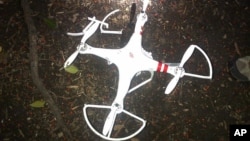White House security was breached again Monday when a small remote-controlled ‘quad copter’ crashed on its lawn. The U.S. Secret Service is investigating, but drone experts say there is no reliable way to protect against these now widely available devices.
This was not the first incident of a flying machine on the grounds of the White House. In September, 1994, a pilot crashed a small Cessna airplane onto the South Lawn, prompting re-evaluation of security procedures.
But the latest incident again highlighted the increased vulnerability of the traditional home of the U.S. presidents.
Thanks to advances in cheap electronics, lightweight materials and mechanical parts, drones are now available to anyone.
The Federal Aviation Administration, which regulates U.S. airspace, limits the flights of drones operated by hobbyists to a height of about 120 meters and within sight of the operator. But modern drones can be pre-programmed to fly automatically along so-called “way points.”
According to Illinois Institute of Technology Robotics Lab associate professor Matthew Spenko, some manufacturers program their drones so they can not be operated in certain areas, though the system is not immune to hacking. “If you are smart enough and you know what you are doing, you can always override that,” he explained.
Spenko said quad copters can carry up to six kilograms of payload. The best among them can stay airborne for 25 minutes and fly as fast as 10 meters per second.
University of Nebraska journalism professor Matthew Waite studies how drones can be used to report news. He said Monday’s incident may have some bad consequences. “I have been saying for years that it is going take one idiot doing something stupid to trigger a lot of bad policy," he said, "and I am afraid that we may have found our idiot.”
Waite said the White House is well protected, but a motivated person can still create a lot of chaos. “If somebody wants to cause harm and havoc with a device and some explosives, there is very little to stop them," he notes. "That is just kind of the way of the world.”
The Secret Service does not have a reliable system to identify and disable drones. After the latest incident, Waite said the agency no doubt will reconsider its options, but he said he thinks the danger from drones is small.
“Could you do damage with it? Absolutely. Are you going to level a building with it? No, probably not," said Waite. "Sure, there is a threat here and the grand scheme of other threats I think that it is pretty low.”
Much as other modern devices, drones are here to stay, so governments and regulators will have to come up with comprehensive regulations to control their use. In the meantime, private companies already are seeing the potential for a lucrative business -- devices that protect us from drones.






